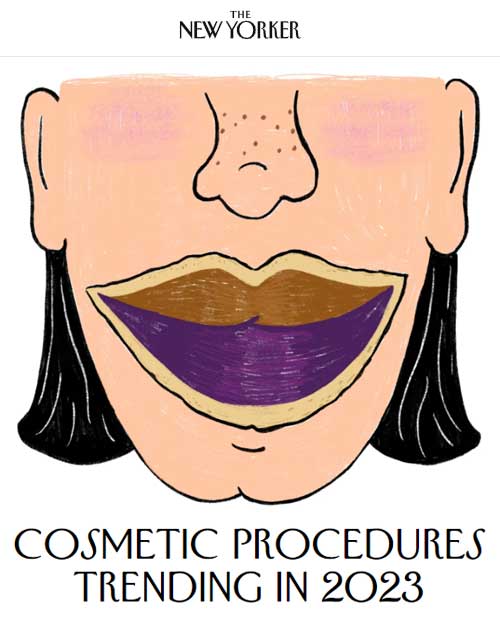New York Center for Facial Plastic Surgery
Schedule a consultation
Schedule today

The New Yorker talks about Buccal fat reduction and other trending facial cosmetic procedures with Dr. Andrew Jacono in New York, NY.
Cosmetic surgical procedures have taken the world by storm. The New Yorker parodied a few of them, citing Dr. Jacono as an expert source.
“It’s exciting to be featured in The New Yorker, even for comedic reasons,” says Dr. Jacono. “This allows me to broadcast a message of radical acceptance. It also inspires people who desire aesthetic work to search for a good doctor. Raising awareness about trending procedures is paramount to creating excellent outcomes.”
The New Yorker highlighted a few of today’s best-known facial cosmetic treatments. These included lip fillers, buccal fat removal, and the deep-plane facelift.

Lip fillers are trending non-surgical facial procedures that are temporary injectable treatments used to increase the size of the lips. Most fillers are made of hyaluronic acid, a naturally occurring compound in the body. Hyaluronic acid normally acts as a joint lubricant. When injected, however, it smooths facial wrinkles and adds volume to particular areas.
“Hyaluronic acid is an incredible compound that has the power to reverse aging,” says Dr. Jacono. “I’ve used it at my practice for years. The best brands include Juvéderm, Restylane, Belotero, and Voluma. They have been on the market the longest and have the most consistent results.” A typical filler session lasts anywhere from 30 minutes to one hour, and recovery time is negligible.
In fact, most patients can return to work immediately after treatment, and there are rare complications that go beyond mild swelling. The best part of facial fillers is that they last between 6 and 12 months. At this point, the body metabolizes the hyaluronic acid. Maintenance is then required.
Facial fillers are excellent choices for those who aren’t ready for more invasive interventions. That said, they are not a permanent solution. Over time, injectables become less effective, a phenomenon known as filler fatigue. Because these injectables create volume that constantly needs to be refilled, they accelerate wrinkling and other signs of aging. Patients who undergo filler treatments therefore usually get surgery later down the line.
“In my experience, the majority of patients begin with fillers and graduate to surgery,” says Dr. Jacono. “Interestingly, these same clients are frustrated that they didn’t go under the knife earlier. They feel that they could’ve saved money and avoided years of ineffective treatment.”
An excellent introduction to surgery is buccal fat reduction. Buccal fat is a pocket of tissue between the cheek and jawbones and is all the trend. It influences the shape of the face. Everyone has buccal fat, though some have more than others.
“Buccal fat is part of a deep internal pocket that impacts the face’s shape,” says Dr. Jacono. “The problem with it is that some people have too much of it. Excess buccal fat makes the face appear rounder, which can throw off the face’s balance. For these clients, I recommend buccal fat reduction.”
Buccal fat reduction removes or repositions this fatty tissue. Small incisions are made on either side of the mouth to access the buccal fat pads. Tissue is either completely excised or partially removed depending on the patient’s goals. After the procedure, the face appears slimmer and more chiseled.
Buccal fat reduction is a relatively simple procedure and takes only about half an hour to perform. Recovery time is minimal; patients can return to their normal activities after a few days. “This procedure is a great option for people who want their face to look more angular and beautiful,” says Dr. Jacono. “Buccal fat is not affected by weight gain and loss, so surgery is the only way to reshape it.”
Another trending facial cosmetic procedure that is being hailed as the cream of the surgical crop, is none other than the Deep-Plane facelift. This procedure improves on the traditional facelift, a technique that has seen significant controversy since its inception.
“Traditional facelifting methods tend to offer more unnatural results,” says Dr. Jacono. “They pull superficial skin taut without manipulating underlying structures. This causes everything to look pulled, glossy, and plastic. The worst plastic surgical disasters, like Mickey Rourke and Jocelyn Wildenstein, likely underwent traditional facelifts.”
Frustrated with the original facelift’s limited returns, Dr. Jacono pioneered the Extended Deep-Plane facelift. This technique focuses on the release and movement of deep muscle and fat layers. Dr. Jacono also keeps the skin and muscle tissue together as a unit instead of separating the two. After lifting these structures on a vertical plane, the face appears smoother and more natural.
“The Deep-Plane facelift is a major trending facial cosmetic innovation,” says Dr. Jacono. “There are simply no better techniques on the market.”
While the Deep-Plane facelift is the gold standard in modern facial rejuvenation, it is an incredibly complex trending procedure. Many surgeons never learn the technique. The few that do cannot perform it at an adequate level to service clients. Dr. Jacono is one of the few physicians in the world who has not only mastered the technique but regularly uses it. “My ultimate goal is to give my patients the best possible care and results,” says Dr. Jacono. “The Deep-Plane facelift is one of the many tools I use to do that.”

Accessibility: If you are vision-impaired or have some other impairment covered by the Americans with Disabilities Act or a similar law, and you wish to discuss potential accommodations related to using this website, please contact our Accessibility Manager at (212) 570-2500 .